Welcome to the Nanopore Community
Order MinION devices and consumables
Visit vwr.comRapid sequencing plasmids (SQK-RBK004)
Version for device: MinION
Introduction to the protocol
Overview of the protocol
Overview of the protocol
-
Rapid Barcoding Kit features
This kit is recommended for users who:
- Wish to multiplex samples to reduce price per sample
- Need a PCR-free method of multiplexing to preserve additional information such as base modifications
- Require a short preparation time
- Have limited access to laboratory equipment
-
Introduction to the Rapid Barcoding Sequencing Kit
This protocol describes how to carry out rapid barcoding of plasmid DNA using the Rapid Barcoding Sequencing Kit (SQK-RBK004).
Steps in the sequencing workflow:
Prepare for your experiment
You will need to:
- Extract your plasmid DNA, and check its length, quantity and purity.
The quality checks performed during the protocol are essential in ensuring experimental success.
- Ensure you have your sequencing kit, the correct equipment and third-party reagents
- Download the software for acquiring and analysing your data
- Check your flow cell to ensure it has enough pores for a good sequencing runLibrary preparation
You will need to:
- Tagment your DNA using the Fragmentation Mix RB in the kit; this simultaneously attaches a pair of barcodes to the fragments
- Pool the barcoded samples
- Attach sequencing adapters supplied in the kit to the DNA ends
- Prime the flow cell, and load your DNA library into the flow cellSequencing and analysis
You will need to:
- Start a sequencing run using the MinKNOW software, which will collect raw data from the device and convert it into basecalled reads
- Start the EPI2ME software and select the analysis workflow for clone validation
Equipment and consumables
- Materials
-
- ~400 ng plasmid DNA per sample
- Rapid Barcoding Sequencing Kit (SQK-RBK004)
- Flow Cell Priming Kit (EXP-FLP002)
- Consumables
-
- 1.5 ml Eppendorf DNA LoBind tubes
- 0.2 ml thin-walled PCR tubes
- Nuclease-free water (e.g. ThermoFisher, AM9937)
- 10 mM Tris-HCl pH 8.0 with 50 mM NaCl
- Freshly prepared 70% ethanol in nuclease-free water
- Agencourt AMPure XP beads (Beckman Coulter™ cat # A63881)
- Equipment
-
- Ice bucket with ice
- Microfuge
- Timer
- Thermal cycler or heat blocks
- P1000 pipette and tips
- P200 pipette and tips
- P100 pipette and tips
- P20 pipette and tips
- P2 pipette and tips
- Optional Equipment
-
- Standard gel electrophoresis equipment
- Agilent Bioanalyzer (or equivalent)
- Qubit fluorometer (or equivalent for QC check)
- Eppendorf 5424 centrifuge (or equivalent)
- Magnetic rack
- Hula mixer (gentle rotator mixer)
-
For this protocol, you will need ~400 ng plasmid DNA.
Note: although this protocol is optimised for 400 ng of starting material, it is possible to use lower quantities of DNA (down to 50 ng per sample).
-
Input DNA
How to QC your input DNA
It is important that the input DNA meets the quantity and quality requirements. Using too little or too much DNA, or DNA of poor quality (e.g. highly fragmented or containing RNA or chemical contaminants) can affect your library preparation.
For instructions on how to perform quality control of your DNA sample, please read the Input DNA/RNA QC protocol.
Chemical contaminants
Depending on how the DNA is extracted from the raw sample, certain chemical contaminants may remain in the purified DNA, which can affect library preparation efficiency and sequencing quality. Read more about contaminants on the Contaminants page of the Community.
-
Rapid Barcoding Kit (SQK-RBK004) contents
Name Acronym Cap colour No. of vials Fill volume per vial (μl) Fragmentation Mix RB01-RB12 Clear 12, each vial with a unique barcode 20 Rapid Adapter RAP Green 1 10 Loading Beads LB Pink 1 360 Sequencing Buffer SQB Red 1 300 -
Flow Cell Priming Kit contents (EXP-FLP002)

Name Acronym Cap colour No. of vials Fill volume per vial (μl) Flush Buffer FB Blue 6 1,170 Flush Tether FLT Purple 1 200 -
The RAP Top-Up Kit (EXP-RAP001) is available to provide enough reagents for another six reactions depending on how the barcodes are used.
This kit contains reagents to be used with any remaining barcodes to load another six sequencing libraries.
Reagent Acronym Cap colour No. of vials Fill volume per vial (µl) Rapid Adapter RAP Green 1 10 Sequencing Tether SQT Purple 1 10 Loading Beads LB Pink 1 360 Sequencing Buffer SQB Red 1 300
Computer requirements and software
Computer requirements and software
-
MinION Mk1B IT requirements
Sequencing on a MinION Mk1B requires a high-spec computer or laptop to keep up with the rate of data acquisition. For more information, refer to the MinION Mk1B IT requirements document.
-
MinION Mk1C IT requirements
The MinION Mk1C contains fully-integrated compute and screen, removing the need for any accessories to generate and analyse nanopore data. For more information refer to the MinION Mk1C IT requirements document.
-
MinION Mk1D IT requirements
Sequencing on a MinION Mk1D requires a high-spec computer or laptop to keep up with the rate of data acquisition. For more information, refer to the MinION Mk1D IT requirements document.
-
Software for nanopore sequencing
MinKNOW
The MinKNOW software controls the nanopore sequencing device, collects sequencing data and basecalls in real time. You will be using MinKNOW for every sequencing experiment to sequence, basecall and demultiplex if your samples were barcoded.
For instructions on how to run the MinKNOW software, please refer to the MinKNOW protocol.
EPI2ME
The EPI2ME cloud-based platform performs further analysis of basecalled data, for example alignment to the Lambda genome, barcoding, or taxonomic classification. You will use the EPI2ME platform only if you would like further analysis of your data post-basecalling.
For instructions on how to create an EPI2ME account and install the EPI2ME Desktop Agent, please refer to this link.
-
Check your flow cell
We highly recommend that you check the number of pores in your MinION Flow Cell prior to starting a sequencing experiment. This should be done within 12 weeks of purchasing the flow cells. Oxford Nanopore Technologies will replace any flow cell with fewer than the number of pores in the table below, when the result is reported within two days of performing the flow cell check, and when the storage recommendations have been followed. To do the flow cell check, please follow the instructions in the Flow Cell Check document.
The minimum number of active pores in a MinION Flow Cell that is covered by warranty is 800 pores.
Library preparation
Library preparation
Library preparation
- Materials
-
- ~400 ng plasmid DNA per sample
- Fragmentation Mix RB01-12
- Rapid Adapter (RAP)
- Consumables
-
- 0.2 ml thin-walled PCR tubes
- Nuclease-free water (e.g. ThermoFisher, AM9937)
- 10 mM Tris-HCl pH 8.0 with 50 mM NaCl (e.g. Fisher Scientific, Cat# NC1877767)
- Freshly prepared 70% ethanol in nuclease-free water
- Agencourt AMPure XP beads (Beckman Coulter™ cat # A63881)
- Equipment
-
- Thermal cycler or heat blocks
- Microfuge
- P10 pipette and tips
- Optional Equipment
-
- Magnetic rack
- Hula mixer (gentle rotator mixer)
-
Thaw kit components at room temperature, spin down briefly using a microfuge and mix by pipetting as indicated by the table below:
Reagent 1. Thaw at room temperature 2. Briefly spin down 3. Mix well by pipetting Fragmentation Mix RB01-12 Not frozen ✓ ✓ Rapid Adapter (RAP) Not frozen ✓ ✓ Sequencing Buffer (SQB) ✓ ✓ ✓* Loading Beads (LB) ✓ ✓ Mix by pipetting or vortexing immediately before use Flush Buffer (FLB) - 1 tube ✓ ✓ ✓* Flush Tether (FLT) ✓ ✓ ✓ *Vortexing, followed by a brief spin in a microfuge, is recommended for Sequencing Buffer (SQB) and Flush Buffer (FLB).
Please note that the Sequencing Tether (SQT) tube will NOT be used in this protocol. It is provided in the kit for potential future product compatibility.
-
Prepare the DNA in nuclease-free water.
- ~400 ng of plasmid DNA is required in 7.5 µl of volume for each sample for barcoding; see table below for dilutions:
Starting Conc. Volume of DNA Volume of nuclease-free water Total volume 1000 ng/µl 1 µl 19 µl 20 µl 800 ng/µl 2 µl 28 µl 30 µl 600 ng/µl 4 µl 41 µl 45 µl 200 ng/µl 8 µl 22 µl 30 µl 100 ng/µl 7 µl 6 µl 13 µl 90 ng/µl 16 µl 11 µl 27 µl 70 ng/µl 10 µl 3 µl 13 µl <53 ng/µl 7.5 µl 0 µl 7.5 µl - Pipette mix the dilutions, and spin down briefly in a microfuge.
- Take forward 7.5 μl of the diluted plasmid sample.
-
In a 0.2 ml thin-walled PCR tube, mix the following:
Reagent Volume 400 ng template DNA 7.5 μl Fragmentation Mix RB01-12 (one for each sample) 2.5 μl Total 10 μl -
Pipette mix and spin down
-
Incubate the tube at 30°C for 1 minute and then at 80°C for 1 minute. Briefly put the tube on ice to cool it down.
-
Pool all barcoded samples into a single 1.5 ml Eppendorf DNA LoBind tube, noting the total volume.
-
Resuspend the AMPure XP beads by vortexing.
-
To the entire pooled barcoded sample from Step 6, add an equal volume of resuspended AMPure XP beads, and mix by flicking the tube.
-
Incubate on a Hula mixer (rotator mixer) for 5 minutes at room temperature.
Top tip: This is a good time to check your flow cell while you wait. See the instructions for checking your flow cell on MinION.
-
Prepare 500 μl of fresh 70% ethanol in nuclease-free water.
-
Spin down the sample and pellet on a magnet. Keep the tube on the magnet, and pipette off the supernatant.
-
Keep the tube on the magnet and wash the beads with 200 µl of freshly prepared 70% ethanol without disturbing the pellet. Remove the ethanol using a pipette and discard.
-
Repeat the previous step.
-
Spin down and place the tube back on the magnet. Pipette off any residual 70% ethanol. Briefly allow to dry.
-
Remove the tube from the magnetic rack and resuspend pellet in 10 µl of 10 mM Tris-HCl pH 8.0 with 50 mM NaCl. Incubate for 2 minutes at room temperature.
-
Pellet the beads on a magnet until the eluate is clear and colourless, for at least 1 minute.
-
Remove and retain 10 µl of eluate into a clean 1.5 ml Eppendorf DNA LoBind tube.
- Dispose of the pelleted beads
-
Add 1 µl of RAP to 10 µl of barcoded DNA.
-
Pipette mix and spin down
-
Incubate the reaction for 5 minutes at room temperature.
Priming and loading the SpotON Flow Cell
Priming and loading the SpotON Flow Cell
- Materials
-
- Flow Cell Priming Kit (EXP-FLP002)
- Sequencing Buffer (SQB)
- Loading Beads (LB)
- Consumables
-
- 1.5 ml Eppendorf DNA LoBind tubes
- Nuclease-free water (e.g. ThermoFisher, AM9937)
- Equipment
-
- MinION device
- SpotON Flow Cell
- MinION and GridION Flow Cell Light Shield
- P1000 pipette and tips
- P100 pipette and tips
- P20 pipette and tips
- P10 pipette and tips
-
Thaw the Sequencing Buffer (SQB), Loading Beads (LB), Flush Tether (FLT) and one tube of Flush Buffer (FB) at room temperature before mixing the reagents by vortexing, and spin down at room temperature.
-
To prepare the flow cell priming mix, add 30 µl of thawed and mixed Flush Tether (FLT) directly to the tube of thawed and mixed Flush Buffer (FB), and mix by vortexing at room temperature.
-
Open the MinION device lid and slide the flow cell under the clip.
Press down firmly on the flow cell to ensure correct thermal and electrical contact.
-
Optional ActionComplete a flow cell check to assess the number of pores available before loading the library.
This step can be omitted if the flow cell has been checked previously.
See the flow cell check instructions in the MinKNOW protocol for more information.
-
Slide the priming port cover clockwise to open the priming port.
-
After opening the priming port, check for a small air bubble under the cover. Draw back a small volume to remove any bubbles:
- Set a P1000 pipette to 200 µl
- Insert the tip into the priming port
- Turn the wheel until the dial shows 220-230 µl, to draw back 20-30 µl, or until you can see a small volume of buffer entering the pipette tip
Note: Visually check that there is continuous buffer from the priming port across the sensor array.
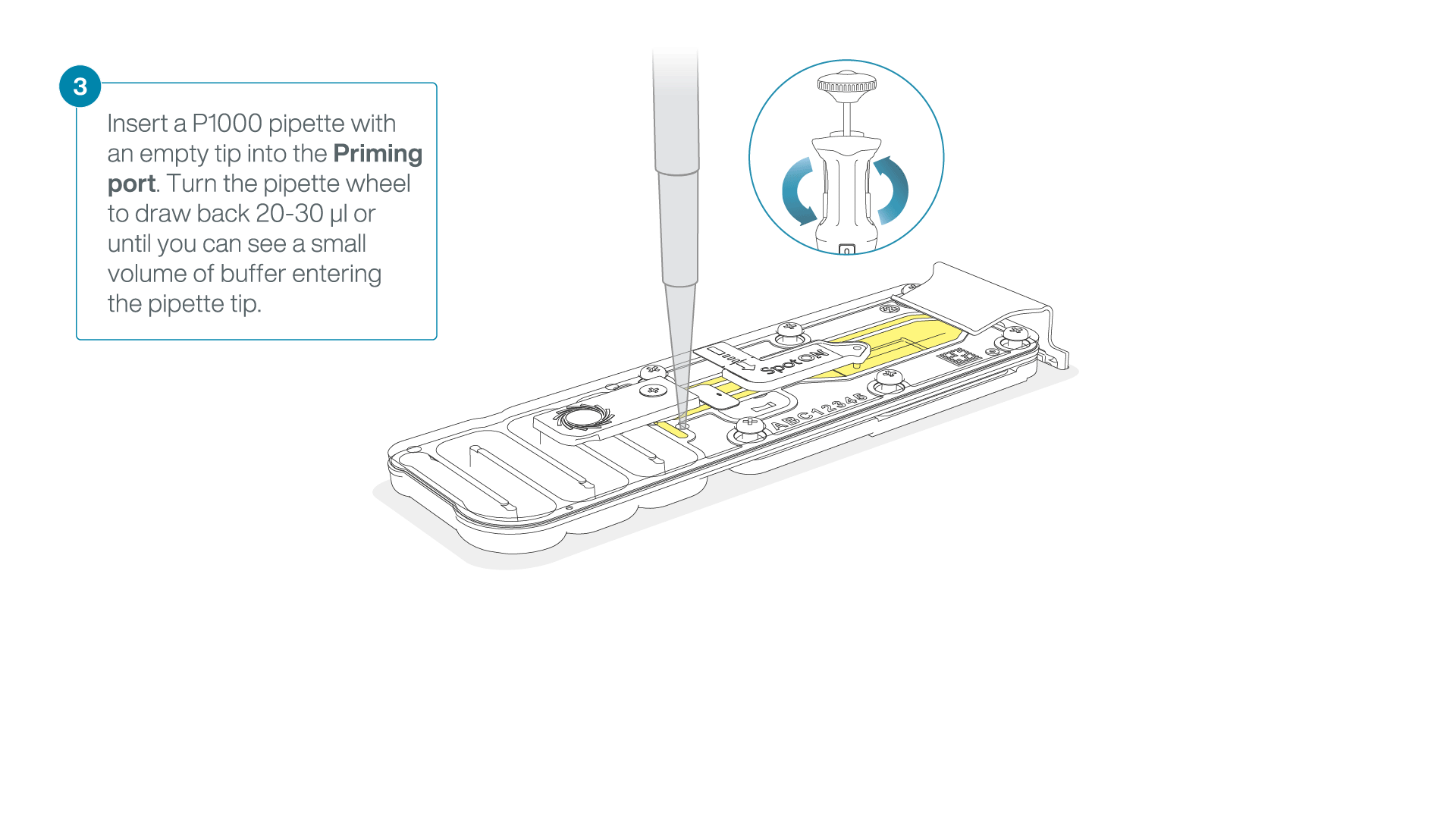
-
Load 800 µl of the priming mix into the flow cell via the priming port, avoiding the introduction of air bubbles. Wait for five minutes. During this time, prepare the library for loading by following the steps below.
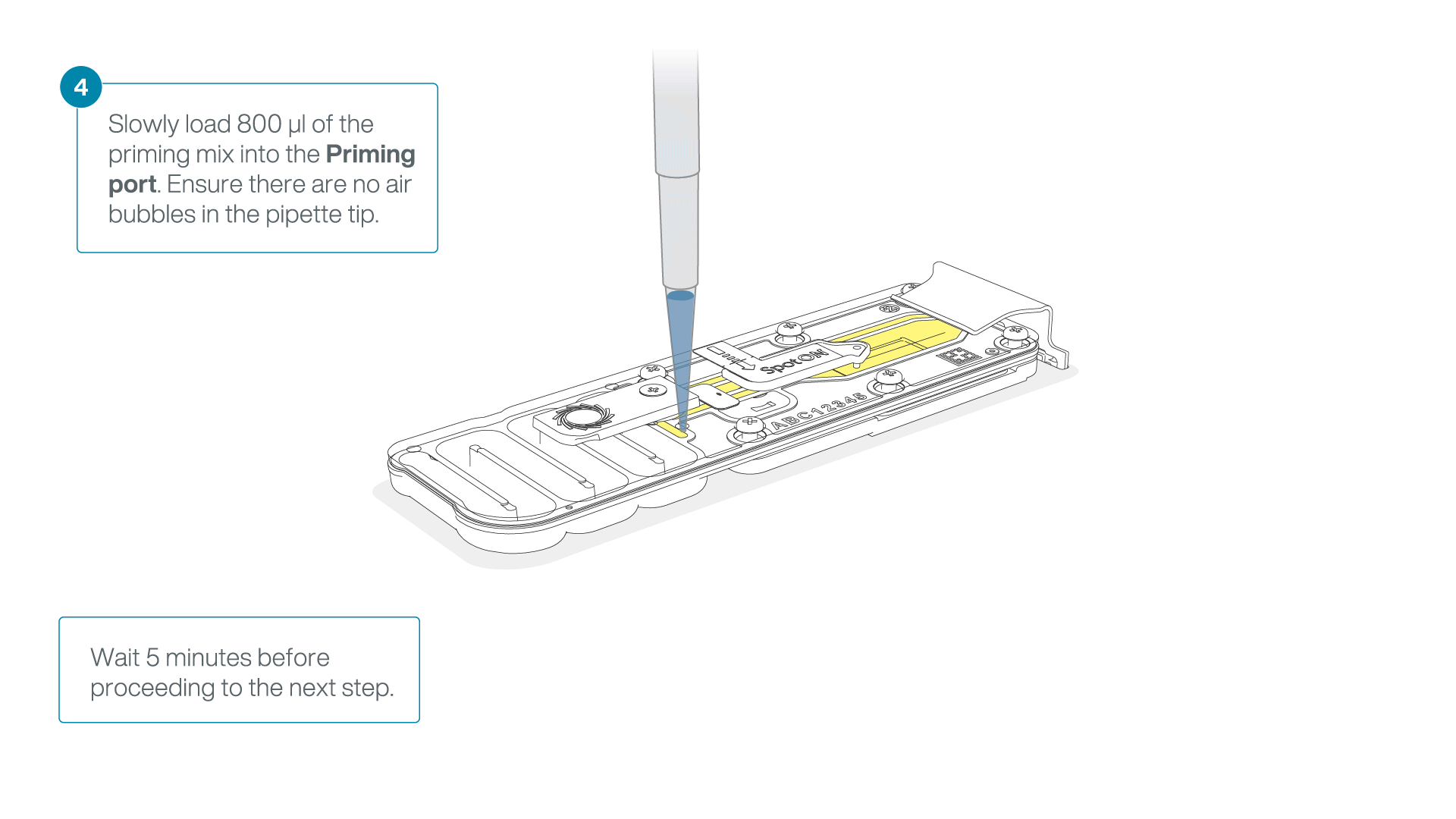
-
Thoroughly mix the contents of the Loading Beads (LB) tubes by vortexing.
-
In a new tube, prepare the library for loading as follows:
Reagent Volume per flow cell Sequencing Buffer (SQB) 34 µl Loading Beads (LB), mixed immediately before use 25.5 µl Nuclease-free water 4.5 µl DNA library 11 µl Total 75 µl Note: Load the library onto the flow cell immediately after adding the Sequencing Buffer (SQB) and Loading Beads (LB) because the fuel in the buffer will start to be consumed by the adapter.
-
Complete the flow cell priming:
- Gently lift the SpotON sample port cover to make the SpotON sample port accessible.
- Load 200 µl of the priming mix into the flow cell priming port (not the SpotON sample port), avoiding the introduction of air bubbles.
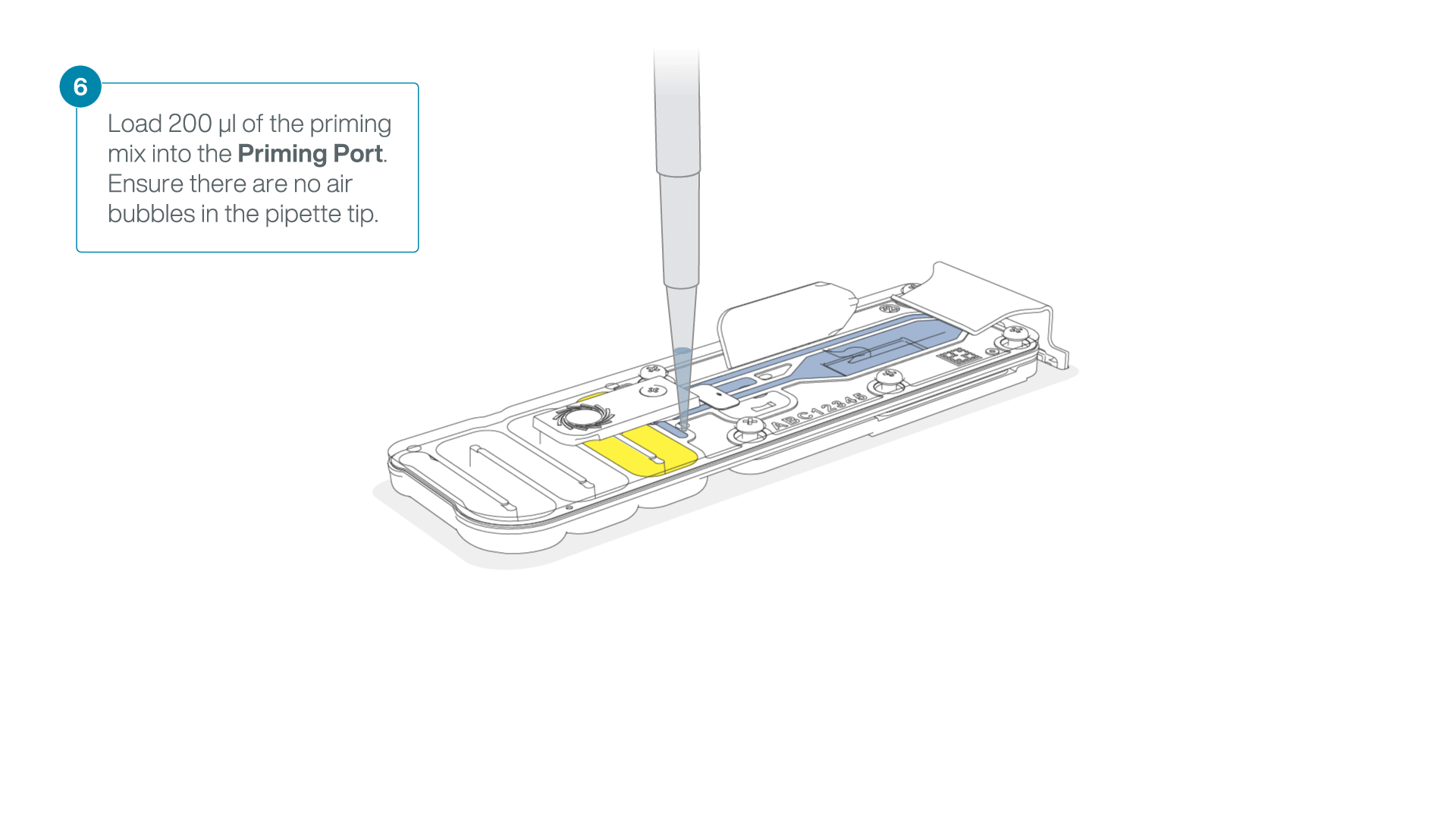
-
Mix the prepared library gently by pipetting up and down just prior to loading.
-
Add 75 μl of the prepared library to the flow cell via the SpotON sample port in a dropwise fashion. Ensure each drop flows into the port before adding the next.

-
Gently replace the SpotON sample port cover, making sure the bung enters the SpotON port and close the priming port.

-
Place the light shield onto the flow cell, as follows:
Carefully place the leading edge of the light shield against the clip.
Note: Do not force the light shield underneath the clip.Gently lower the light shield onto the flow cell. The light shield should sit around the SpotON cover, covering the entire top section of the flow cell.
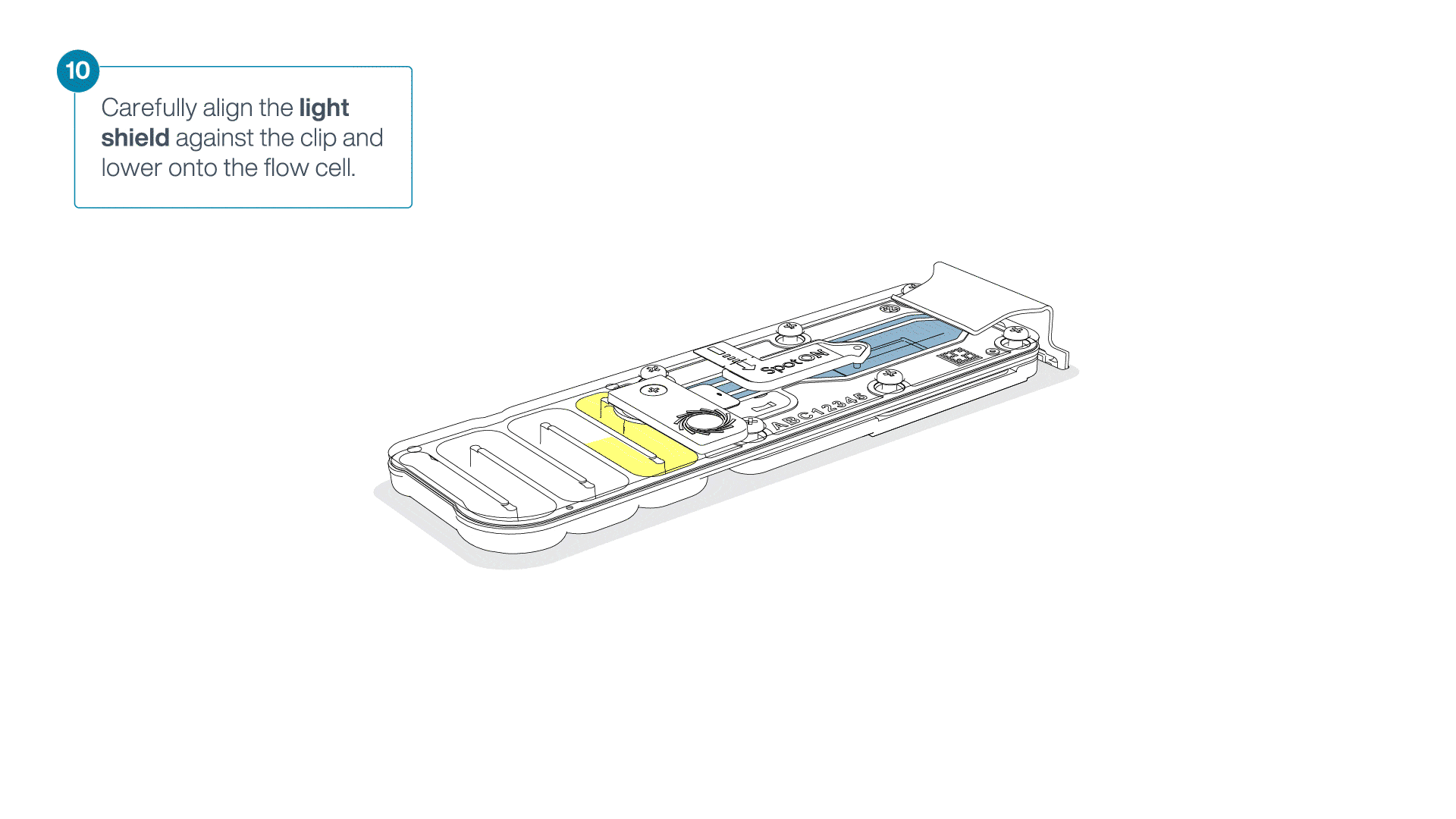
Sequencing and data analysis
Data acquisition and basecalling
Data acquisition and basecalling
-
How to start sequencing
The sequencing device control, data acquisition, real-time basecalling, and barcode demultiplexing are carried out by the MinKNOW software. It is assumed you have already installed MinKNOW on your computer. Instructions for this can be found in the MinKNOW protocol.
-
Open the MinKNOW software using the desktop shortcut and log into the MinKNOW software using your Community credentials.
-
Select your connected device.
-
Sequencing set-up
Select Start sequencing.
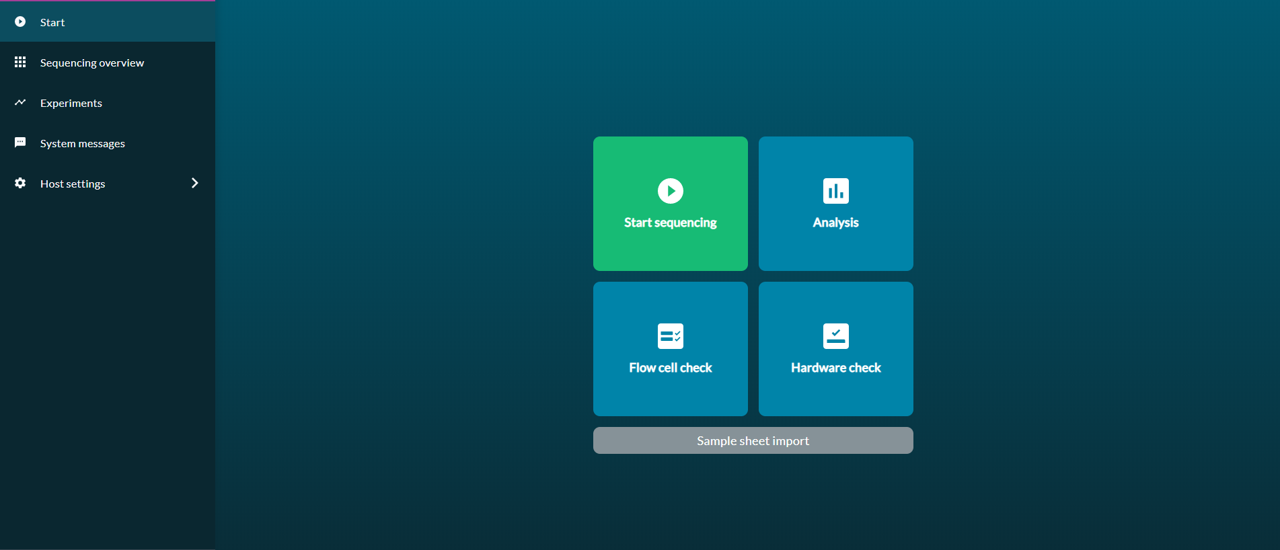
-
Select positions
Enter your Experiment name and sample ID as prompted.
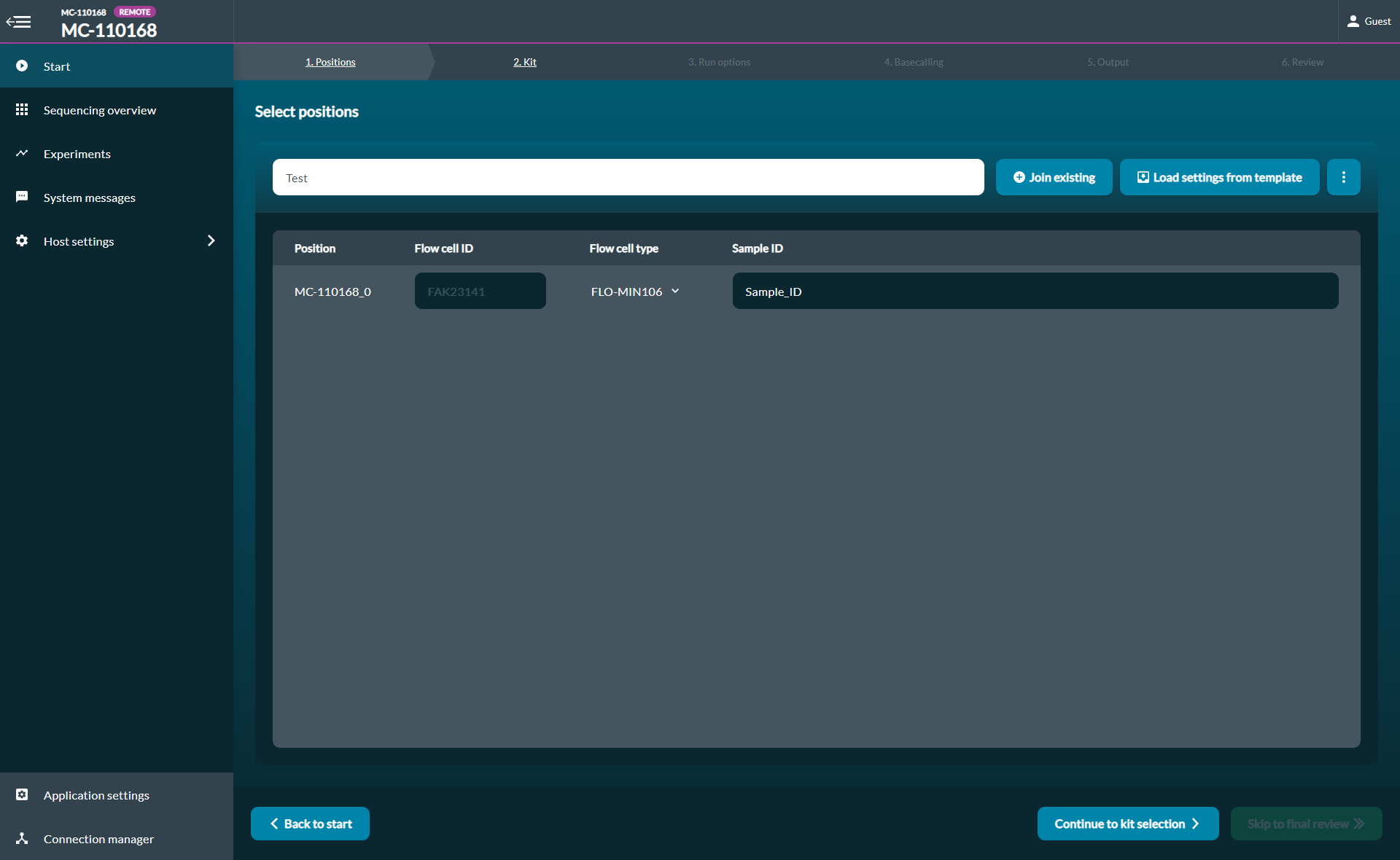
-
Kit selection
The kit selection tab will provide a dropdown of available kits. Check the SQK-RBK004 kit.

-
Run Options
The run options tab provides variables for run time and starting voltage. Leave these at the default values, except the run time which can be set to 12 hours.
Active Channel Selection refers to a feature introduced in MinKNOW v2.2 If a channel is in the "Saturated" or "Multiple" state, the software instantly switches to a new channel in the group. If a channel is "Recovering", MinKNOW will attempt to revert the channel back to "Pore" or "Sequencing" for ~5 minutes, after which it will select a new channel in the group. This maximises the number of channels sequencing at the start of the experiment.

-
Basecalling
Check Basecalling and select the Fast basecalling option in the dropdown menu.
Select Barcoding to Enabled.
-
Output
Select where you would like to save the data.

-
Review
Review your sequencing set-up and click Run.

Downstream analysis using EPI2ME
Downstream analysis using EPI2ME
-
Post-basecalling analysis
EPI2ME platform
The EPI2ME platform is a cloud-based data analysis service developed by Metrichor Ltd., a subsidiary of Oxford Nanopore Technologies. The EPI2ME platform offers a range of analysis workflows, e.g. for metagenomic identification, barcoding, alignment, and structural variant calling. The analysis requires no additional equipment or compute power, and provides an easy-to-interpret report with the results. Instructions on downloading are available in the EPI2ME protocol
-
Open the EPI2ME using the desktop shortcut.
-
If prompted, select a folder containing FASTQ files to be analysed.
If a MinKNOW-generated folder structure is detected in the default input location, this will be shown in the Experiments & samples tab. You can change the default input location in the Settings page (cog icon) under Data sources. The root of the Output folder can be changed and any output from the analysis will be stored beneath that path as folders (named by instance ID). The root output location can be changed in the Settings page or when adjusting the parameters for the individual analysis.
Alternatively, you will be directed to the Folders tab, where you can select your input folder.
-
Select the analysis you want to perform.
You can select from the full list of analyses (All tab), or from the Favourites tab. Select FASTQ Clone Validation.

-
Adjust the run-time parameters of your analysis.
The parameters available to fine-tune will depend on the type of analysis selected.

-
Once all the required fields are filled in, click "Accept & start" to start data analysis.
-
Follow the progression of upload and download of read files in the Agent.

-
Clone validation workflow report
The key figures from the workflow are presented under the Clone Validation tab in the report.

The summary table shows the number of sequence reads that have been analysed per experimental barcode. These data may be used to identify the samples that may have dropped out of the sequence analysis due to insufficient sequence reads.

For each plasmid assembled a figure of genome annotation is presented. The pLannotate software is used to annotate the polished plasmid consensus sequence. In this figure barcode01 has been assembled into a 3037 bp consensus sequence. The addgene database has been used to identify the annotated genes and plasmid features shaded in blue whilst the csgG protein shaded in red has been identified from the Swissprot database.

In addition to the plasmid figure, the same data are also provided in tabular format. This can be used to identify the precise location of the annotated features.
-
Results
The EPI2ME Agent will download the polished consensus sequence in FASTA format to the EPI2ME result directory. If the plasmid sequence contains either the T7 or pRham sequencing primers, the cloned region of insert will also be reported. In the figure the files e.g. barcode01.final.fasta correspond to the complete plasmid sequence and the barcode01.insert.fasta correspond to the cloned region of interest.

Downstream analysis using EPI2ME Labs
Downstream analysis using EPI2ME Labs
-
EPI2ME Labs Clone validation tutorial
Instead of running the EPI2ME analysis workflow, the user can deploy the Clone validation tutorial in EPI2ME Labs to further analyse sequence data.
EPI2ME Labs extends the JupyterLab notebook framework with a pre-configured analysis server. The notebooks contain Python code needed to run data analysis, however zero configuration of the code is required. The notebooks can be used both by students and researchers new to nanopore sequence data analysis, and more experienced bioinformaticians who are comfortable working with Python.
Follow the EPI2ME Labs Quick Start Guide to install and launch the EPI2ME Labs notebook server.
The clone validation tutorial can be accessed by following the link: https://labs.epi2me.io/notebooks/Clone_validation_tutorial.html
The workflow is intended to assess a molecular cloning experiment, specifically whether the introduction of one sequence into another has been successful: for example, the introduction of a protein-encoding sequence into a plasmid vector molecule.
Questions answered by this tutorial include:
- If a barcoding strategy has been used, what fraction of demultiplexed reads correspond to the target of interest?
- Does a sequenced DNA construct correspond to its expected sequence?
- Does the sequenced DNA construct contain frameshifts or base substitions?
- If the DNA construct encodes a peptide sequence, is the peptide sequence correct?
Ending the experiment
Ending the experiment
- Materials
-
- Flow Cell Wash Kit (EXP-WSH004)
-
After your sequencing experiment is complete, if you would like to reuse the flow cell, please follow the Flow Cell Wash Kit protocol and store the washed flow cell at +2°C to +8°C.
The Flow Cell Wash Kit protocol is available on the Nanopore Community.
-
Alternatively, follow the returns procedure to send the flow cell back to Oxford Nanopore.
Instructions for returning flow cells can be found here.
Troubleshooting
Issues during DNA/RNA extraction and library preparation
Issues during DNA/RNA extraction and library preparation
-
Below is a list of the most commonly encountered issues, with some suggested causes and solutions.
We also have an FAQ section available on the Nanopore Community Support section.
If you have tried our suggested solutions and the issue still persists, please contact Technical Support via email (support@nanoporetech.com) or via LiveChat in the Nanopore Community.
-
Low sample quality
Observation Possible cause Comments and actions Low DNA purity (Nanodrop reading for DNA OD 260/280 is <1.8 and OD 260/230 is <2.0–2.2) The DNA extraction method does not provide the required purity The effects of contaminants are shown in the Contaminants document. Please try an alternative extraction method that does not result in contaminant carryover.
Consider performing an additional SPRI clean-up step.Low RNA integrity (RNA integrity number <9.5 RIN, or the rRNA band is shown as a smear on the gel) The RNA degraded during extraction Try a different RNA extraction method. For more info on RIN, please see the RNA Integrity Number document. Further information can be found in the DNA/RNA Handling page. RNA has a shorter than expected fragment length The RNA degraded during extraction Try a different RNA extraction method. For more info on RIN, please see the RNA Integrity Number document. Further information can be found in the DNA/RNA Handling page.
We recommend working in an RNase-free environment, and to keep your lab equipment RNase-free when working with RNA. -
Low DNA recovery after AMPure bead clean-up
Observation Possible cause Comments and actions Low recovery DNA loss due to a lower than intended AMPure beads-to-sample ratio 1. AMPure beads settle quickly, so ensure they are well resuspended before adding them to the sample.
2. When the AMPure beads-to-sample ratio is lower than 0.4:1, DNA fragments of any size will be lost during the clean-up.Low recovery DNA fragments are shorter than expected The lower the AMPure beads-to-sample ratio, the more stringent the selection against short fragments. Please always determine the input DNA length on an agarose gel (or other gel electrophoresis methods) and then calculate the appropriate amount of AMPure beads to use. 
Low recovery after end-prep The wash step used ethanol <70% DNA will be eluted from the beads when using ethanol <70%. Make sure to use the correct percentage.
Issues during the sequencing run
Issues during the sequencing run
-
Below is a list of the most commonly encountered issues, with some suggested causes and solutions.
We also have an FAQ section available on the Nanopore Community Support section.
If you have tried our suggested solutions and the issue still persists, please contact Technical Support via email (support@nanoporetech.com) or via LiveChat in the Nanopore Community.
-
Fewer pores at the start of sequencing than after Flow Cell Check
Observation Possible cause Comments and actions MinKNOW reported a lower number of pores at the start of sequencing than the number reported by the Flow Cell Check An air bubble was introduced into the nanopore array After the Flow Cell Check it is essential to remove any air bubbles near the priming port before priming the flow cell. If not removed, the air bubble can travel to the nanopore array and irreversibly damage the nanopores that have been exposed to air. The best practice to prevent this from happening is demonstrated in this video. MinKNOW reported a lower number of pores at the start of sequencing than the number reported by the Flow Cell Check The flow cell is not correctly inserted into the device Stop the sequencing run, remove the flow cell from the sequencing device and insert it again, checking that the flow cell is firmly seated in the device and that it has reached the target temperature. If applicable, try a different position on the device (GridION/PromethION). MinKNOW reported a lower number of pores at the start of sequencing than the number reported by the Flow Cell Check Contaminations in the library damaged or blocked the pores The pore count during the Flow Cell Check is performed using the QC DNA molecules present in the flow cell storage buffer. At the start of sequencing, the library itself is used to estimate the number of active pores. Because of this, variability of about 10% in the number of pores is expected. A significantly lower pore count reported at the start of sequencing can be due to contaminants in the library that have damaged the membranes or blocked the pores. Alternative DNA/RNA extraction or purification methods may be needed to improve the purity of the input material. The effects of contaminants are shown in the Contaminants Know-how piece. Please try an alternative extraction method that does not result in contaminant carryover. -
MinKNOW script failed
Observation Possible cause Comments and actions MinKNOW shows "Script failed" Restart the computer and then restart MinKNOW. If the issue persists, please collect the MinKNOW log files and contact Technical Support. If you do not have another sequencing device available, we recommend storing the flow cell and the loaded library at 4°C and contact Technical Support for further storage guidance. -
Pore occupancy below 40%
Observation Possible cause Comments and actions Pore occupancy <40% Not enough library was loaded on the flow cell Ensure you load the recommended amount of good quality library in the relevant library prep protocol onto your flow cell. Please quantify the library before loading and calculate mols using tools like the Promega Biomath Calculator, choosing "dsDNA: µg to pmol" Pore occupancy close to 0 The Ligation Sequencing Kit was used, and sequencing adapters did not ligate to the DNA Make sure to use the NEBNext Quick Ligation Module (E6056) and Oxford Nanopore Technologies Ligation Buffer (LNB, provided in the sequencing kit) at the sequencing adapter ligation step, and use the correct amount of each reagent. A Lambda control library can be prepared to test the integrity of the third-party reagents. Pore occupancy close to 0 The Ligation Sequencing Kit was used, and ethanol was used instead of LFB or SFB at the wash step after sequencing adapter ligation Ethanol can denature the motor protein on the sequencing adapters. Make sure the LFB or SFB buffer was used after ligation of sequencing adapters. Pore occupancy close to 0 No tether on the flow cell Tethers are adding during flow cell priming (FLT/FCT tube). Make sure FLT/FCT was added to FB/FCF before priming. -
Shorter than expected read length
Observation Possible cause Comments and actions Shorter than expected read length Unwanted fragmentation of DNA sample Read length reflects input DNA fragment length. Input DNA can be fragmented during extraction and library prep.
1. Please review the Extraction Methods in the Nanopore Community for best practice for extraction.
2. Visualise the input DNA fragment length distribution on an agarose gel before proceeding to the library prep.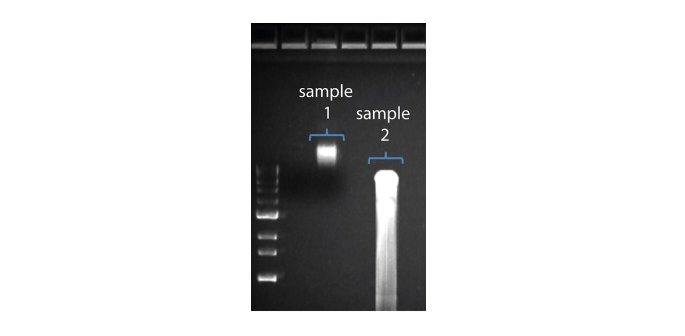 In the image above, Sample 1 is of high molecular weight, whereas Sample 2 has been fragmented.
In the image above, Sample 1 is of high molecular weight, whereas Sample 2 has been fragmented.
3. During library prep, avoid pipetting and vortexing when mixing reagents. Flicking or inverting the tube is sufficient. -
Large proportion of inactive pores
Observation Possible cause Comments and actions Large proportion of inactive/unavailable pores (shown as light blue in the channels panel and pore activity plot. Pores or membranes are irreversibly damaged) Air bubbles have been introduced into the flow cell Air bubbles introduced through flow cell priming and library loading can irreversibly damage the pores. Watch the Priming and loading your flow cell video for best practice Large proportion of inactive/unavailable pores Certain compounds co-purified with DNA Known compounds, include polysaccharides, typically associate with plant genomic DNA.
1. Please refer to the Plant leaf DNA extraction method.
2. Clean-up using the QIAGEN PowerClean Pro kit.
3. Perform a whole genome amplification with the original gDNA sample using the QIAGEN REPLI-g kit.Large proportion of inactive/unavailable pores Contaminants are present in the sample The effects of contaminants are shown in the Contaminants Know-how piece. Please try an alternative extraction method that does not result in contaminant carryover. -
Reduction in sequencing speed and q-score later into the run
Observation Possible cause Comments and actions Reduction in sequencing speed and q-score later into the run For Kit 9 chemistry (e.g. SQK-LSK109), fast fuel consumption is typically seen when the flow cell is overloaded with library (please see the appropriate protocol for your DNA library to see the recommendation). Add more fuel to the flow cell by following the instructions in the MinKNOW protocol. In future experiments, load lower amounts of library to the flow cell. -
Temperature fluctuation
Observation Possible cause Comments and actions Temperature fluctuation The flow cell has lost contact with the device Check that there is a heat pad covering the metal plate on the back of the flow cell. Re-insert the flow cell and press it down to make sure the connector pins are firmly in contact with the device. If the problem persists, please contact Technical Services. -
Failed to reach target temperature
Observation Possible cause Comments and actions MinKNOW shows "Failed to reach target temperature" The instrument was placed in a location that is colder than normal room temperature, or a location with poor ventilation (which leads to the flow cells overheating) MinKNOW has a default timeframe for the flow cell to reach the target temperature. Once the timeframe is exceeded, an error message will appear and the sequencing experiment will continue. However, sequencing at an incorrect temperature may lead to a decrease in throughput and lower q-scores. Please adjust the location of the sequencing device to ensure that it is placed at room temperature with good ventilation, then re-start the process in MinKNOW. Please refer to this link for more information on MinION temperature control. -
Guppy – no input .fast5 was found or basecalled
Observation Possible cause Comments and actions No input .fast5 was found or basecalled input_path did not point to the .fast5 file location The --input_path has to be followed by the full file path to the .fast5 files to be basecalled, and the location has to be accessible either locally or remotely through SSH. No input .fast5 was found or basecalled The .fast5 files were in a subfolder at the input_path location To allow Guppy to look into subfolders, add the --recursive flag to the command -
Guppy – no Pass or Fail folders were generated after basecalling
Observation Possible cause Comments and actions No Pass or Fail folders were generated after basecalling The --qscore_filtering flag was not included in the command The --qscore_filtering flag enables filtering of reads into Pass and Fail folders inside the output folder, based on their strand q-score. When performing live basecalling in MinKNOW, a q-score of 7 (corresponding to a basecall accuracy of ~80%) is used to separate reads into Pass and Fail folders. -
Guppy – unusually slow processing on a GPU computer
Observation Possible cause Comments and actions Unusually slow processing on a GPU computer The --device flag wasn't included in the command The --device flag specifies a GPU device to use for accelerate basecalling. If not included in the command, GPU will not be used. GPUs are counted from zero. An example is --device cuda:0 cuda:1, when 2 GPUs are specified to use by the Guppy command.
Become a full member
Purchase a MinION Starter Pack from Avantor to get full community access and benefit from:
- News - hear about the latest product updates
- Posts - interact with thousands of nanopore users from around the globe
- Software - download the latest sequencing and analysis software
Already have a Nanopore Community account?
Log in hereNeed more help?
Request a call with our experts for detailed advice on implementing nanopore sequencing.
Request a callInterested in microbiology?
Visit our microbial sequencing spotlight page on vwr.com.
Microbial sequencing

























 In the image above, Sample 1 is of high molecular weight, whereas Sample 2 has been fragmented.
In the image above, Sample 1 is of high molecular weight, whereas Sample 2 has been fragmented. The pore activity plot above shows an increasing proportion of "unavailable" pores over time.
The pore activity plot above shows an increasing proportion of "unavailable" pores over time.